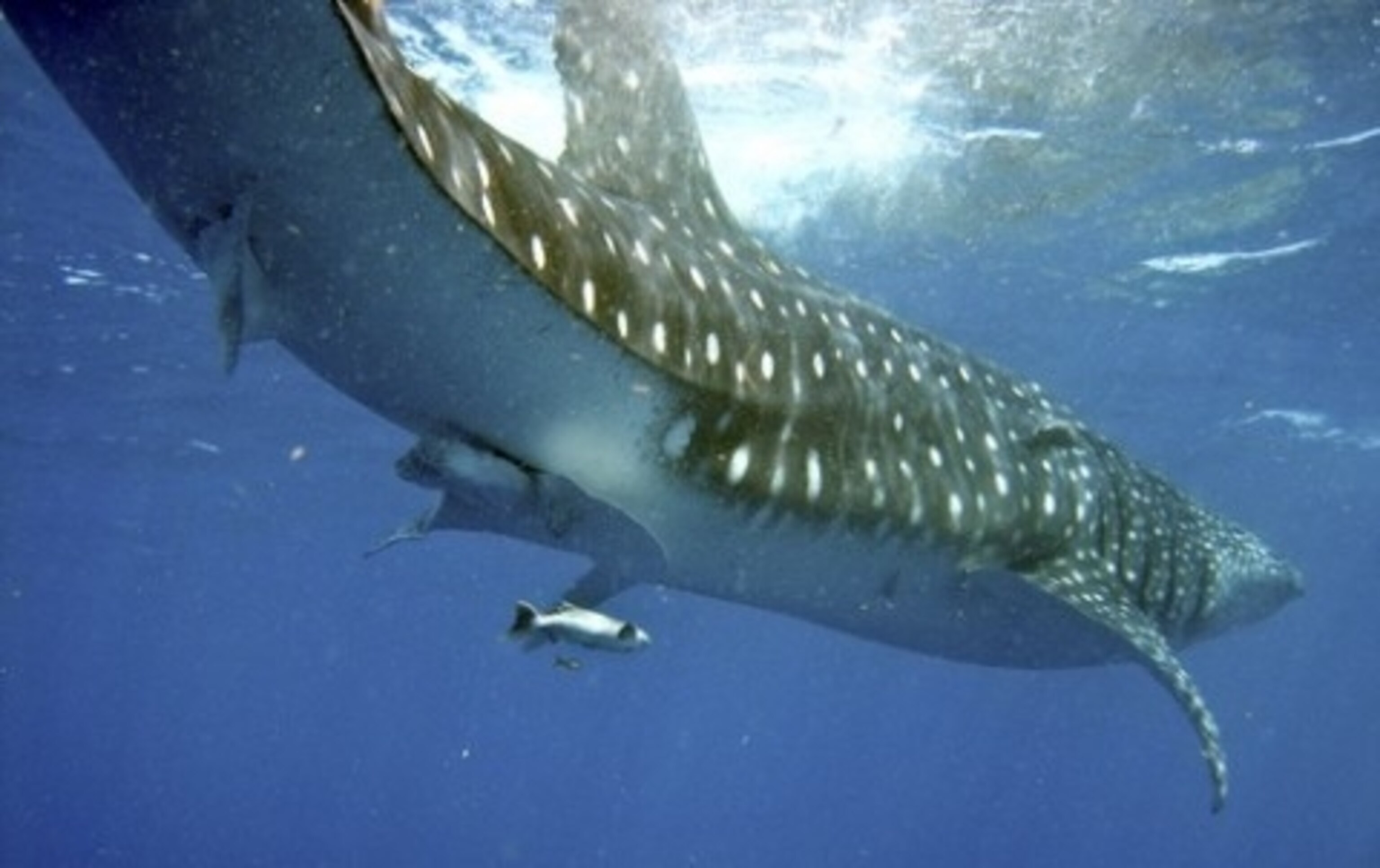
Swim With a 40-Foot Whale Shark
If you’re thinking of heading south of the border this summer to take advantage of low fares to Mexico, consider the upcoming Whale Shark Festival on Isla Mujeres, in the state of Quintana Roo on Mexico’s Yucatan Peninsula. The festival runs this July 15th through the 19th.
The festival is billed as an ecotourism, family-friendly event featuring local cuisine, traditional dance, authentic artisanal goods for sale and, last but certainly not least, a chance to swim with migrating whale sharks in the Caribbean.
A little background before you take the plunge: The endangered whale shark is not a whale but a shark, despite its contradictory name. Its name stems from its massive size (up to 29,982 pounds and 40 feet in length) and because it eats krill, algae, plankton, and other tiny sea creatures. Whale sharks are filter feeders and have been known to be playful with human divers, though their tails can be a bit dangerous.
We checked in with Eyder Jahil Hoth Pérez, Director of Tourism, Isla Mujeres, Mexico, to learn more about the festival.
First off, the festival is billed as an ecotourism event. What does that mean?
The people of Isla Mujeres traditionally relied on commercial fishing as a means of driving their local economy. To protect this fragile marine ecosystem, we have been working with Ceviche Tours (a sustainable ecotourism travel company) and others to help shift this focus. For instance, local fishermen are retrained to serve as expert fishing guides, etc. for tourism. A significant goal of these efforts is to not only preserve the local environment, but to also preserve the heritage and culture of the people of Isla Mujeres. The Whale Shark Festival is a celebration of this culture, a celebration of the wonderful marine environs here, and also a way of promoting the benefits of sustainability.
This is the festival’s second year. How many people attended last year and do you expect attendance to be somewhat down due to the recent H1N1 scare?
Last year about 3,000 tourists visited the island each day during the festival. Tourism to Isla Mujeres has been relatively steady this season, and we’re seeing a significant rise in hotel bookings in anticipation of the Festival.
The festival is located on Isla Mujeres. Tell us a bit about the island. What other attractions can you find there?
Isla Mujeres is a small municipality in the Mexican Caribbean, just 15 minutes from Cancun by boat. It consists of three islands and a larger mainland territory.
Isla Mujeres is full of nature; we have one of the most important preserves for birds (Contoy National Park) and the waters surrounding the island see big migrations of turtles, dolphins, whale sharks, manta rays, sail fish, blue marlin, white marlin, mahi mahi, etc. Isla Mujeres serves as the nursery of the Caribbean and the migratory path of sea turtles, water fowl, game fishes and the largest fish in existence, the whale shark.
Also, our island is part of the second largest barrier reef on the planet. Many of these reefs are protected areas where fishing in prohibited. That’s why we have many ecotourism-related activities such as swimming with whale sharks, snorkeling the reefs, diving, Contoy Park Tours, tours of the turtle farm or the colonial ruins of Boca Iglesias (1517) in the middle of the jungle, sport fishing (catch and release), and more.
Isla Mujeres started as a fishing village in the 1950s; people visiting the island marvel at the authentic Mexican atmosphere, the peaceful living, small streets, pedestrian avenues, white sand beaches, turquoise waters, and the friendly people. Currently the permanent population of Isla Mujeres is about 15,000 and 97 percent of the economy is based on ecotourism.
What’s the best way to get there?
Fly to Cancun; get a cab to Puerto Juarez to catch the ferry (which runs every 30 minutes). From the airport, total travel time is about one hour.
Do a lot of festival attendees swim with the whale sharks?
Absolutely. On average, 200-250 people a day swim with the whale sharks during whale shark season.
What’s that experience like?
Most visitors describe it as the experience of their lives. It’s amazing how this gentle giant transmits to the people around him a profound feeling of peace.
I’ve read that whale sharks are an endangered species. Do humans swimming with them negatively affect them in any way?
In Mexico we have developed strict laws and regulations for these activities to ensure maximum respect for the animal. Only two people (and a licensed guide) can swim with them at a time. Swimmers must remain at least six feet away from the whale shark. There are many other regulations.
How many whale sharks will there be in the area during their migration? How long are they around?
- National Geographic Expeditions
Some days you can find 20 to more than 100. They are usually here from May 15th to September 15th.
I noticed that you can expect local food, traditional dance, and artisanal all available about the festival. Can you tell us a bit about what you’ll find?
Guests can taste traditional, local seafood delicacies. We’ll also have an artists’ exhibition featuring conch handicrafts, hammocks, textiles, honey, and habanero sauce.
Get There: Isla Mujeres has hotels for every budget; more than 60 range from one to five stars. Many are family-run. Follow this link to the hotel directory. Also, Privilege Aluxes Resort
is offering a four-night special for $518 per person that includes luxe accommodations, daily breakfast, a gratis cocktail reception, and other perks.
Photo: John S. Vater
